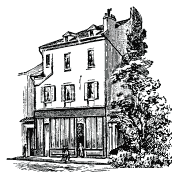General Store
This page was created March 22, 2004 A general store in the early days of the county was much more then just a grocery store as we know it today.
Most of the time, they were actually three different stores in just one building;
The dry goods or hardware section of the store dealt with products such as axes, hammers, cookstoves, pots, plows, bolts of material and other sewing needs, candlewicks and molds, etc.
The grocery section of the store carried a variety of items such as barrels of salted meats and fish, pickles, crackers, 50-100 pound bags of sugar or flour, salt, spices and coffee. The storekeeper
could either sell the customer green coffee that they roasted at home or he could sell it roasted and grind it for them.
Although the general store carried some varieties of ready made clothing, most homemakers sewed their own clothes for their families.
The last section of the store was normally taken up with feed and grain used by the area farmers.
Canned goods were just coming into use in general stores around the year 1880, but even then, most women preferred to can their own produce.
The general store many times created a social and information arena for the community's men..Women, of course, didn't tarry around the store after
completing their transactions, BUT, it was quite common for the men to gather their and "gossip", (although it was NEVER reffered to as such by the men !)
Trip to the General Store
Early county dwellers welcomed the convenience of the storekeeper and his goods, however, they did need to be "on their guard" most of the time
during the shopping trips. In those days, the storekeeper and he alone selected, measured, and packaged the groceries that the customer desired. As with every
profession, there were at times, unscrupulous men in the position of storekeeper who were not above:
Flouring the lard
Adding sawdust to the cornmeal
Stretching the flour with plaster
Coffee could easily contain dyed navy beans
Raisins could well be part pebbles
There were no laws in existence that prohibited these practices, so therefore, the rule was "trust your eyes, ears, nose and fingers and maybe
old friends, but never the storekeeper." Many a farmer was suspicious of a man who bought products at one price and sold it at a higher price without moving a
muscle..
Early Prices
Calico was a most popular material used in the 1880's for home usage and it sold for about 15 cents a yard.
Leather Shoes and Boots could be had for about one or two dollars a pair.
Suspenders went for about 25 cents if it were a "fancy" pair.
By the year 1932, local general stores were still widely in use in rural areas. A quart of milk at that time was 5 cents as was a loaf of bread;
some residents of that time remember that you could buy all the pork chops that you could eat for 10 cents.
Many persons depended on crops, hunting skills and livestock for their "trading" at the store. Many a time, the woman's "cream & butter" money
paid for children's shoes or the weeks groceries were bought in exchange for eggs. Based on that, if you were not successful with your livestock, your family
could and would seriously suffer.
When you did business with the storekeeper in trade, you were never given money back; you were given what was called a "due bill". This
was sort of an accounting of the money that they storekeeper still owed you for your traded product and you simply used that the next time you shopped.
The Huckster Wagon
The Huckster Wagon was still another way to purchase groceries in rural areas. This, simply put, was a covered wagon that carried groceries
from house to house along certain routes. The huckster man would trade the same as the storekeeper for eggs, chickens, butter, etc. He carried the basics
such as sugar, flour, some materials, coffee, all of these already packaged. Most of these men ran twice a week starting at one end of a community on a Monday
and coming back through on a Thursday.
Dependency on the Store
Most women had to purchase what they needed at the store when their men could take them, there was no "running to the store" for every little thing.
For most families, the regular shopping trip would consist of simply baking powder, baking soda, vanilla and coffee. The sugar, flour and cornmeal were normally bought
separately by the men in quantities of 25 pound bags or in barrels as was the salt also.
Therefore in already having their fruits and vegetables home grown and canned; and also their meat in the pasture or smokehouse, there wasn't a need for
anything else to be bought.
Below are just some of the local memories.
Home Website Coordinator
